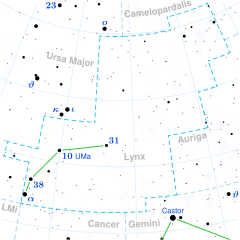16 Lyncis
| Observation data Epoch J2000 Equinox J2000 | |
|---|---|
| Constellation | Lynx |
| Right ascension | 06h 57m 37.10709s[1] |
| Declination | +45° 05′ 38.7404″[1] |
| Apparent magnitude (V) | 4.90[2] |
| Characteristics | |
| Spectral type | A0Vn[3] |
| B−V color index | 0.03[2] |
| Variable type | suspected[4] |
| Astrometry | |
| Radial velocity (Rv) | −11.90±1[5] km/s |
| Proper motion (μ) | RA: −21.52±0.27[1] mas/yr Dec.: −3.12±0.17[1] mas/yr |
| Parallax (π) | 13.54 ± 0.23 mas[1] |
| Distance | 241 ± 4 ly (74 ± 1 pc) |
| Absolute magnitude (MV) | 0.56[6] |
| Details[7] | |
| Mass | 2.38 M☉ |
| Luminosity | 56[6] L☉ |
| Surface gravity (log g) | 4.02 cgs |
| Temperature | 10,395±353 K |
| Rotational velocity (v sin i) | 229 km/s |
| Age | 181 Myr |
| Other designations | |
| Database references | |
| SIMBAD | data |
16 Lyncis is a star in the constellation Lynx. It is positioned next to the western constellation border with Auriga, and is also known as Psi10 Aurigae, which is Latinized from ψ10 Auriga. The star has a white hue and is visible to the naked eye with an apparent visual magnitude of 4.90.[2] The distance to this object is approximately 241[1] light-years based on parallax, but it is drifting closer to the Sun with a radial velocity of −12 km/s.[5] It has an absolute magnitude of 0.56.[6]
This object is a solitary[9] A-type main-sequence star with a stellar classification of A0Vn,[3] a star that is currently fusing its core hydrogen. The 'n' suffix indicates "nebulous" absorption lines due to rapid rotation. It is around 181 million years old with a projected rotational velocity of 229 km/s.[7] This spin rate is giving the star an oblate shape with an equatorial bulge that is an estimated 10% larger than the polar radius.[10] 16 Lyncis has 2.38[7] times the mass of the Sun and is radiating 56[6] times the Sun's luminosity from its photosphere at an effective temperature of 10,395 K.[7]
16 Lyncis is suspected of being slightly variable, but this has not been confirmed.[11] It was noted when 16 Lyncis was used as a comparison star for observing another variable, the peculiar HD 51418 (NY Aurigae).[4]
See also[edit]
References[edit]
- ^ a b c d e f Van Leeuwen, F. (2007). "Validation of the new Hipparcos reduction". Astronomy and Astrophysics. 474 (2): 653–664. arXiv:0708.1752. Bibcode:2007A&A...474..653V. doi:10.1051/0004-6361:20078357. S2CID 18759600.
- ^ a b c Hoffleit, D.; Warren, W. H. (1995). "Bright Star Catalogue". VizieR On-line Data Catalog: V/50. Originally Published in: 1964BS....C......0H. 5050 (5th ed.). Bibcode:1995yCat.5050....0H.
- ^ a b Abt, Helmut A.; Morrell, Nidia I. (1995). "The Relation between Rotational Velocities and Spectral Peculiarities among A-Type Stars". The Astrophysical Journal Supplement Series. 99: 135. Bibcode:1995ApJS...99..135A. doi:10.1086/192182.
- ^ a b Gulliver, A. F.; Winzer, J. E. (1973). "Spectrum and light variations of the peculiar a star HD 51418". The Astrophysical Journal. 183: 701. Bibcode:1973ApJ...183..701G. doi:10.1086/152260.
- ^ a b Gontcharov, G. A. (November 2006). "Pulkovo Compilation of Radial Velocities for 35 495 Hipparcos stars in a common system". Astronomy Letters. 32 (11): 759–771. arXiv:1606.08053. Bibcode:2006AstL...32..759G. doi:10.1134/S1063773706110065. S2CID 119231169.
- ^ a b c d Anderson, E.; Francis, Ch. (2012), "XHIP: An extended hipparcos compilation", Astronomy Letters, 38 (5): 331, arXiv:1108.4971, Bibcode:2012AstL...38..331A, doi:10.1134/S1063773712050015, S2CID 119257644.
- ^ a b c d David, Trevor J.; Hillenbrand, Lynne A. (2015), "The Ages of Early-Type Stars: Strömgren Photometric Methods Calibrated, Validated, Tested, and Applied to Hosts and Prospective Hosts of Directly Imaged Exoplanets", The Astrophysical Journal, 804 (2): 146, arXiv:1501.03154, Bibcode:2015ApJ...804..146D, doi:10.1088/0004-637X/804/2/146, S2CID 33401607.
- ^ "psi10 Aur". SIMBAD. Centre de données astronomiques de Strasbourg. Retrieved 2020-07-01.
{{cite web}}: CS1 maint: postscript (link) - ^ Eggleton, P. P.; Tokovinin, A. A. (2008). "A catalogue of multiplicity among bright stellar systems". Monthly Notices of the Royal Astronomical Society. 389 (2): 869. arXiv:0806.2878. Bibcode:2008MNRAS.389..869E. doi:10.1111/j.1365-2966.2008.13596.x. S2CID 14878976.
- ^ Belle, G. T. (2012). "Interferometric observations of rapidly rotating stars". The Astronomy and Astrophysics Review. 20 (1): 51. arXiv:1204.2572. Bibcode:2012A&ARv..20...51V. doi:10.1007/s00159-012-0051-2. S2CID 119273474.
- ^ VSX (18 January 2010). "NSV 3293". AAVSO Website. American Association of Variable Star Observers. Retrieved 11 October 2014.

